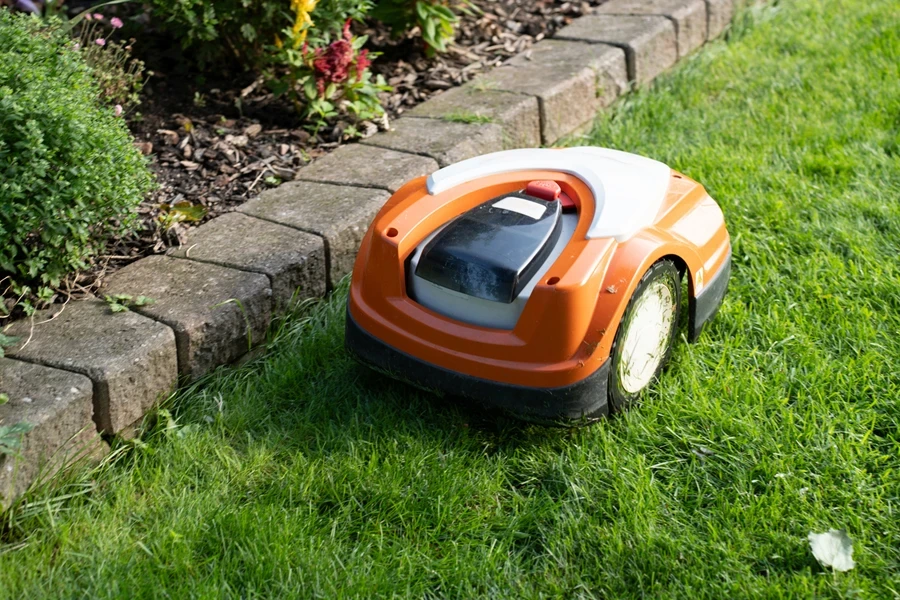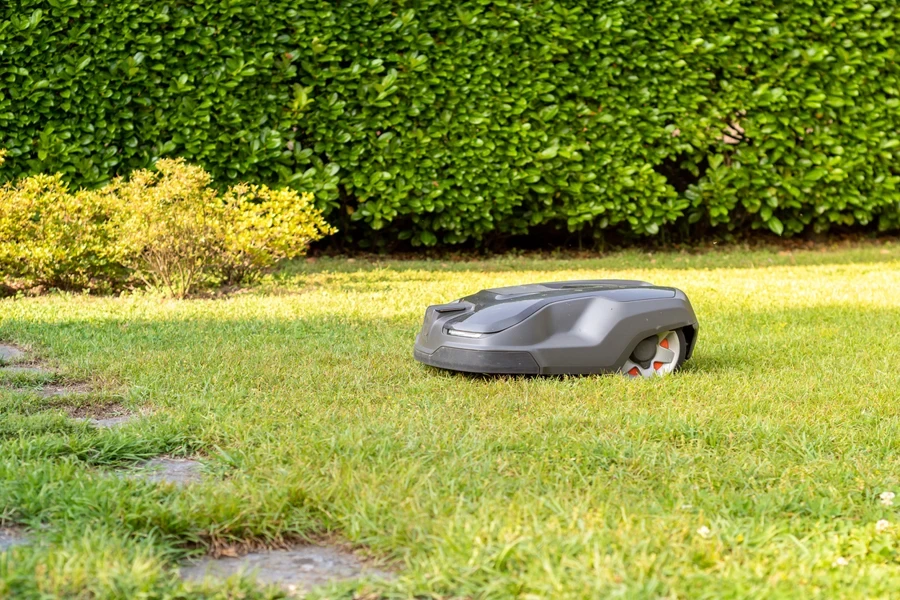With a hands-off approach to maintaining vast green areas in perfect shape, robot lawn mowers are transforming large-scale lawn maintenance. These high-tech assistants are ideal for handling varied terrain, especially those with hills and challenges, as they come loaded with GPS navigation, long-lasting batteries, and smart terrain-handling capabilities.
With a focus on their durability, performance, and efficiency, we will explore what powers these devices. Here’s how to choose the best robot lawn mower for large-scale mowing requirements.
Table of Contents
Why are robot lawn mowers gaining traction?
How robot lawn mowers work
Types of robot lawn mowers
Features to consider when buying a robot lawn mower
Summary
Why are robot lawn mowers gaining traction?

Robotic lawn mowers’ outstanding efficiency and simplicity are helping them to acquire great popularity. Unlike conventional mowers, they free users to concentrate on other chores while they don’t require any physical effort or monitoring.
One notable perk is time-saving since these machines operate independently, mowing consistently and guaranteeing consistent care. Users end up with more aesthetically pleasing lawns. Since most robotic mowers are electric, they are also environmentally friendly since they lower carbon footprints compared to gas-powered substitutes.
With less maintenance and running expenses than conventional mowers, they show over time to be more affordable. Their choices for customizing and control—app-based scheduling, mowing patterns, height changes—give consumers complete freedom in lawn care.
Another important aspect is safety; sophisticated sensors and automatic shut-off systems are meant to stop mishaps and protect pets.
How robot lawn mowers work

Simple yet intelligent, robot lawn mowers reduce the effort it takes to maintain a lawn. All neatly wrapped in a waterproof casing, these machines use sharp, revolving blades driven by a rechargeable battery. They are meant to subtly and effectively cut your grass; you may change the height to suit your taste.
Their sensors and navigation systems define them as truly clever. Unlike standard mowers, they do not merely wander about aimlessly. While some devices depend on GPS to map out your yard, others use boundary wires you place yourself.
They can easily navigate around objects like trees and flowerbeds. In addition, they have sensors that sense rain or uneven ground, so they will stop or veer if necessary to guarantee flawless mowing. Robot mowers cut a little at a time, leaving fine clippings that function as a natural fertilizer instead of cutting vast quantities of grass all at once.
In the long term, this helps your lawn remain healthy. The mower automatically goes back to its charging dock when the battery runs low, charges up, and keeps mowing without your intervention.
The convenience doesn’t end there; a mobile app can operate most robotic mowers. You may create mowing plans, change cutting patterns, and even track mower progress right now. Some models also provide hand control if you ever have to step in.
Types of robot lawn mowers

Here are the two main comparisons to think of when choosing a dependable robot lawn mower:
Residential vs. commercial models
Residential robot mowers are designed for small to medium-sized lawns and typically cover areas up to one acre. The focus here is on convenience, so you can expect a less sturdy build, shorter battery life, and easy app-based controls compared to the commercial counterparts.
Typical features include adjustable cutting heights, directional boundary lines, and basic obstacle detection sensors. These motors are great for typical residential lawns but won’t cut it on thicker grass or rougher terrain because of their reduced power output, despite their efficiency.
On the other hand, commercial robot lawn mowers are built for larger properties, such as public parks, estates, or golf courses, and for more demanding tasks. Improved navigation systems with GPS integration allow for more precise mapping and autonomous navigation without boundary wires; these devices also have stronger motors and longer battery lives.
Their intended function is to handle longer running hours, more diverse difficulties, and more difficult terrain. Commercial models typically have state-of-the-art features like automatic blade adjustment for various grass densities, enhanced weather resistance, and multi-zone mowing capabilities.
Battery-powered vs. solar-powered

Robot lawn mowers typically run on batteries, specifically rechargeable lithium-ion batteries, which offer reliable power and a long operating period. Mowers like this usually dock themselves when the power goes out, so you can keep cutting without interruption.
Depending on the model and the state of the grass, the battery life of the mower can vary from approximately 60 to 180 minutes of cutting time. Reliability and performance are the key benefits of mowers driven by batteries.
Modern models optimize power consumption according to grass height and terrain, and they come with energy-efficient motors. But charging does still use grid power, which adds to operating expenses over time.
An alternative that is less prevalent but still eco-friendly is robot lawn mowers that are driven by solar energy. These versions can run on battery power alone or with the help of integrated solar panels. There would be no need to charge as often, and energy consumption will drop significantly in places with plenty of sunshine.
There is a trade-off between the power of solar-powered mowers and their battery-powered equivalents; the former may have weaker motors and need more time to mow before running out of power.
They do poorly in partially shaded or overcast environments and do best in regions with warm temperatures and constant sunshine exposure.
Features to consider when buying a robot lawn mower

It’s worth looking at all these technical features when shopping for a reliable robot lawn mower:
Cutting width and height adjustment
The cutting width is how much grass the mower cuts per pass. Wider cutting widths allow for fewer passes and faster mowing on larger lawns. Residential models average 7 to 11 inches, while commercial units might exceed 20 inches for large sites. Smaller lawns benefit from narrower mowers for more accurate control in tight locations, while bigger lawns need a wider mowing path to save time.
Height adjustment is available from 0.8 to 3.5 inches on most versions. This adjustment lets the mower handle varied grasses. Fescue grass, for instance, thrives at higher heights, while Bermuda does well at lower heights. Luxury models may have automated height adjustment that adjusts the cutting height dependent on grass density, making them better for multi-terrain lawns.
Blade types
Robot lawn mowers use rotary or reel blades. Rotary blades, the most typical type, cut medium-length grass quickly and are durable and easy to replace. While rare, reel blades cut finer and cleaner, making them ideal for luxury lawns and golf courses that require accuracy. Commercial mowers that need a good finish utilize them.
Terrain handling capabilities
A robot mower must handle varied terrains. Some are for flat, simple lawns, while others can manage 25-degree slopes. All-terrain wheels or tracks improve grip on rocks, uneven ground, and moist grass in advanced models. This matters if your lawn has slopes or rough terrain. Incline sensors allow mowers to mow uphill and downhill without tipping.
Smart and safety features
Robot mowers employ GPS and boundary wires to navigate lawns. The mower stays within your yard with boundary wires. This method is widespread in residential models and works well for simple yards. However, GPS-based navigation in commercial mowers permits exact mapping without boundary wires. Store several mowing zones and handle complicated lawns with multiple sections.
Robot mowers recognize flower beds, trees, and outdoor furniture via sensors and cameras. Some models optimize their mowing patterns by learning your yard’s layout with AI. Multi-zone mowers are essential for large or irregular yards.
Modern robot mowers include smart features that improve efficiency and safety. Lift and tilt sensors, collision detection, and automatic shutdowns halt the mower if it is lifted or if it hits obstructions.
The mowing area’s child and pet safety devices also stop the mower when someone enters. Remote operation via mobile apps lets users schedule mowing sessions, manage the mower’s speed, and check its charge level from their smartphones. Some modern models provide voice control via Alexa or Google Assistant with smart home devices.
Weather resistance
Weatherproofing is also important. Most models are water-resistant and can mow in light rain, but high-end ones have rain sensors that stop mowing in harsh weather. This function prevents ruts and wet mower damage. Select models with IP ratings for durability in different conditions.
Battery life
How long a mower can run before charging depends on battery life. Entry-level devices last 60–90 minutes on a full charge, whereas high-end commercial models last 3 hours or more.
Larger lawn mowers often self-charge when the battery runs low and return to the charging station to begin mowing. Most batteries use lithium-ion technology to balance runtime and charging speed; however, some solar-powered devices extend runtime.
Summary
Robot lawn mowers offer hands-free lawn care at its best. Automation saves time and promotes healthier grass by keeping a mowing schedule. These devices reduce maintenance—no weekly mowing, gas, oil, or worn parts. Many models are eco-friendly, and smartphone apps let you easily tailor and monitor lawn care.
Visit Alibaba.com to get the latest robot lawn mower models for different lawn sizes and budgets. Enjoy the long-term benefits of a well-kept lawn with no manual effort.



